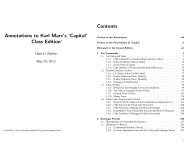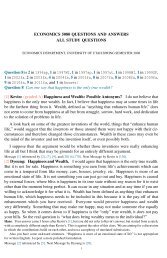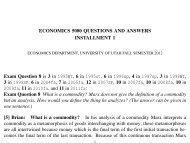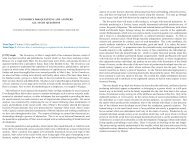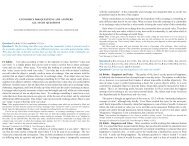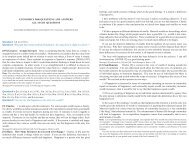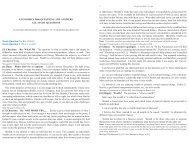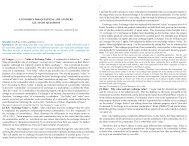Question 1 What did Marx mean with his formu - University of Utah
Question 1 What did Marx mean with his formu - University of Utah
Question 1 What did Marx mean with his formu - University of Utah
Create successful ePaper yourself
Turn your PDF publications into a flip-book with our unique Google optimized e-Paper software.
U <strong>of</strong> <strong>Utah</strong> Econ 5080 2005fa 39<br />
Value is “that social property which makes things exchangeable in a commodity society.”<br />
Next, not for the trial test answer, I’ll take a shot at the relationship between value and<br />
abstract labor:<br />
Abstract labor is what goes into the material to turn it into a commodity. A commodity<br />
itself is a social construct, raw material plus labor that adds use-value(s). Once it’s part <strong>of</strong><br />
the commodity, it’s value.<br />
Hans: Imagine the following conversation. Your son asks you: “what is value?” and your answer is “value is that<br />
social property which makes things exchangeable in a commodity society.” Then your son wants to know: “what is<br />
that property?” and you elaborate: “the abstract labor content <strong>of</strong> the commodity”.<br />
My point here is: “value is congealed abstract labor” is also a possible answer to question 72.<br />
Message [574] referenced by [579]. Next Message by Bubba is [598].<br />
[579] Xerho: <strong>What</strong> is value, test question response to Bubba. Bubba makes a very good<br />
point in quoting the annotations in [574] for the definition <strong>of</strong> value, which is something I<br />
certainly should have considered; sticking to the text. I failed to realize that many times a<br />
simple definition is best. I chose to include the sentence following that quoted by Bubba<br />
in the annotations were it reads, “Value...is not derived from worth, but from abstract social<br />
labor.” (pg. 34)<br />
It’s tough to know how far to go in a definition, but I liked how Bubba separated the two,<br />
and wrote separately about the relationship between value and abstract labor. Thanks for<br />
clearing that up further.<br />
Next Message by Xerho is [643].<br />
[673] Hans: Disentangling value and exchange-value. T<strong>his</strong> question was not on the<br />
test yesterday and will not be on the test on Monday. But it is something which needs<br />
clarification in general. Let me begin <strong>with</strong> a trivial geometric example.<br />
Think <strong>of</strong> all the circles in the world. If you take any two circles A and B, then it is either<br />
possible to place A on top <strong>of</strong> B so that A completely covers B (i.e., so that B is completely<br />
hidden by A), or it is not possible.<br />
If it is possible, then I say “A covers B”. T<strong>his</strong> is a relationship between circles: it can<br />
only be defined if you have two circles.<br />
Other things can be done <strong>with</strong> circles individually. You can compute the area <strong>of</strong> each<br />
circle, and its circumference, etc. For t<strong>his</strong> you don’t need more than one circle: each circle<br />
has a well-defined area and circumference all by itself.<br />
Thirdly, <strong>of</strong> course, we know that A covers B if and only if the area <strong>of</strong> A is greater than or<br />
equal to the area <strong>of</strong> B. T<strong>his</strong> fact is not as trivial as it seems because it reduces the relationship<br />
between the circles to something which each circle has individually. Say circle A lives in<br />
New York and B in San Francisco. It is no longer necessary for A to fly to San Francisco or<br />
for B to fly to New York in order to determine whether A covers B or not. They both can<br />
just measure their area, which is something that each can do <strong>with</strong>out the other present, and<br />
then they know who covers whom.<br />
Now think commodities instead <strong>of</strong> circles, the cover relationship is their exchange value,<br />
and the area is their value, i.e., the abstract human labor which was used up in the production<br />
<strong>of</strong> these commodities. Then you understand what <strong>Marx</strong> <strong>mean</strong>s when he says<br />
40 2005fa Econ 5080 U <strong>of</strong> <strong>Utah</strong><br />
exchange-value itself cannot be anything other than the mere mode <strong>of</strong> expression,<br />
“form <strong>of</strong> appearance,” <strong>of</strong> some content distinguishable from it.<br />
The area is the underlying concept; if A covers B it can do so because it has a bigger area<br />
than B. The cover relationship is the mode <strong>of</strong> expression, the form <strong>of</strong> appearance, <strong>of</strong> the area<br />
<strong>of</strong> the circles in the relationship between circles. Somewhere else, <strong>Marx</strong> says:<br />
Wheat and iron, so far as they are exchange-values, must therefore be reducible<br />
to t<strong>his</strong> third.<br />
I.e., if I only want to know whether circle A covers circle B, and none <strong>of</strong> their other<br />
properties (their location, material, color etc), then all I need to know about them is the area<br />
<strong>of</strong> each.<br />
Adolph Wagner wrote a book in which he summarized <strong>Marx</strong>’s theory <strong>with</strong> the words<br />
“the common social substance <strong>of</strong> exchange-value is labor.”<br />
I bet that 90 percent <strong>of</strong> all <strong>Marx</strong>ists would agree. But <strong>Marx</strong> himself objected vehemently:<br />
Nowhere do I speak <strong>of</strong> “the common social substance <strong>of</strong> exchange-value”; I<br />
rather say that the exchange-values (exchange-value, <strong>with</strong>out at least two <strong>of</strong><br />
them, does not exist) represent something common to them, which is “quite<br />
independent <strong>of</strong> their use-values” [i.e. here their natural form], namely<br />
“value.”<br />
Say our circles are knitted coasters. Then <strong>Marx</strong> simply says here that the process <strong>of</strong><br />
knitting (the living labor) does not generate the cover relationship between the coasters, but<br />
it generates the area <strong>of</strong> the coasters.<br />
Next Message by Hans is [705].<br />
<strong>Question</strong> 73 is 39 in 1995WI, 48 in 1996ut, 47 in 1997ut, 59 in 1999SP, 65 in 2003fa, 74<br />
in 2004fa, 86 in 2007SP, 86 in 2007fa, 87 in 2008fa, 90 in 2009fa, and 109 in 2012fa:<br />
<strong>Question</strong> 73 Use-value is the quality <strong>of</strong> the commodity, and exchange-value is its quantity.<br />
Right or wrong?<br />
[78] Adamwest: I find the above statement to be correct. <strong>Marx</strong> makes it clear very early<br />
on that useful things can be analyzed by their quality and quantity. On page 126 he states<br />
“The usefulness <strong>of</strong> a thing makes it a use-value”. So assuming that the higher an object’s<br />
usefulness is in direct correlation to its use-value then we are correct.<br />
Exchange-value can be looked at as the exchange rate from one item to another. <strong>Marx</strong><br />
presents t<strong>his</strong> idea by saying “Exchange-value appears first <strong>of</strong> all as the quantitative relation<br />
the proportion in which use-values <strong>of</strong> one-kind exchange for use-values <strong>of</strong> another kind”.<br />
T<strong>his</strong> shows that the exchange-value is found by looking at the use-value <strong>of</strong> the two items<br />
that are to be traded. These use-values show us how many <strong>of</strong> item “a” is needed for one <strong>of</strong><br />
item “b”, or vice versa.<br />
Hans: Did you <strong>mean</strong> to write: “So assuming that the higher an object’s quality is in direct correlation to its usevalue<br />
then we are correct”?<br />
Message [78] referenced by [81] and [94]. Next Message by Adamwest is [339].



